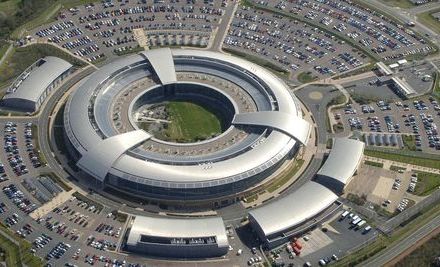London at centre of eavesdropping scandal
By Duncan Campbell | Original English version. Translated to French for publication in LE MONDE on 01 July 2013
Britain’s electronic spy agency GCHQ was set up in 1946, with the utmost secrecy. For the next 30 years, the British parliament, public and press did not know it existed, let alone that it was far bigger and more important than the famous Secret Intelligence Service, or MI6, home to James Bond of spy fiction.
GCHQ, or Government Communications Headquarters, was formed from a previous wartime organization, the Government Code and Cypher school, whose teams of radio listeners and codebreakers were celebrated for having broken the Nazi “Enigma” and other code systems at the peak of the Second World War.
Most of its 6,000 staff now work from its headquarters at Cheltenham in the west of England. The main GCHQ building, completed in 2003 at a cost of £350 million, is a huge ring-shaped structure known as the “doughnut”
GCHQ gets the largest share of Britain’s £2.1 billion British intelligence budget. The budget is due to rise by £65 million after next year. Apart from conducting intelligence operations, GCHQ has expanded its missions to include cyber security, cyber defence and active “cyber operations” – better known as “hacking”. The recent revelations about GCHQ included information that GCHQ has used hacking methods for more than 15 years. They are now likely to be a significant, but ultra secret, part of its methods.
GCHQ and its staff are almost completely integrated with the US National Agency, sharing missions, stations, operations, communications methods and security procedures. The secret treaty to join the work of the two agencies was signed between Britain and the United States in March 1946. The agreement was later extended to Canada, Australia and New Zealand, all then part of the British Empire. Orders and messages are shared between all five countries’ agencies.
GCHQ once managed a global network of radio interceptions stations stretching from Hong Kong to the south Atlantic. As global communications and politics have changed, this network has shrunk down to a few key centres mainly intercepting commercial satellites and undersea cables. Its main stations now are located in Bude in England, in Cyprus and on Ascension Island, and at two sites in the north of England. It also sends staff to work in NSA stations in Britain and abroad, and to the headquarters of other agencies in Washington, Ottawa and Melbourne.
GCHQ’s targets have always included Britain’s allies, friends and neighbours, as well as possible or actual enemies. A huge intelligence effort was first mounted against European Union members when Britain negotiated accession, and remains in being. International conferences and diplomatic missions in the UK are relentlessly targeted, using listening devices or “bugs” and computer hacking methods, as well as conventional listening.
In 2003, a GCHQ analyst Katharine Gun was prosecuted after she leaked an NSA directive to all “Five Eyes” agencies staff, urging them to “surge” or maximize monitoring against United Nations diplomatic stuff before the start of the 2003 Iraq invasion.
The remarks in papers and slideshows recently leaked by NSA whistleblower Edward Snowden include a description of a gigantic internet recording system installed since 2010 for a GCHQ project entitled “Mastering the Internet”. Once this was up and running, the Americans were invited to make free use of it. “Have fun and make the most of it”, the author of one secret paper instructed 550 British and American analysts.
Snowden himself told Britain’s Guardian newspaper. It's not just a US problem …. [GCHQ] are worse than the US."
GCHQ has also been revealed to have boasted that Britain’s laws were weaker and more surveillance-friendly than in the United States. "We have a light oversight regime compared with the US", GCHQ wrote in one document about the internet surveillance system called “Tempora”.
By 2010, two years after the project was first trialed, it was able to boast it had the "biggest internet access" of any member of the “Five Eyes”. UK officials also claimed that GCHQ "produces larger amounts of metadata (communications records) than NSA".
After the UK welcomed 250 NSA analysts to start working on the data passing into the Tempora system, GCHQ imposed no restrictions. When it came to controlling what the Americans were allowed to look for, GCHQ is reported to simply have just said: "your call".



